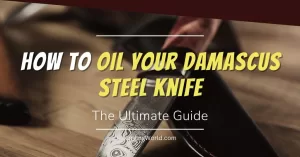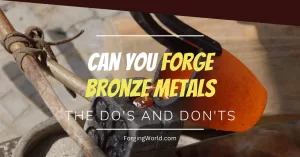Blacksmithing as an activity has always had a bad reputation when it comes to safety. You may have heard of some injuries that happened in the blacksmith shop.
But now the question remains, is blacksmithing a dangerous craft?
While blacksmithing involves heated metal, high temperatures, and fire, it doesn’t necessarily have to be dangerous. Wearing crucial safety equipment like safety goggles, proper clothing, and ear protection drastically decreases the chances of possible hazards. So after all, it all depends on whether you wear safety equipment or not.
Besides wearing safety equipment, taking necessary safety precautions are another imperative. In this article, we’ll discuss the dangers of blacksmithing and how to easily prevent them.
Let’s dive right in!
Common Dangers of Blacksmithing and How to Prevent Them
A lot of things can go wrong in the blacksmithing shop if you are not careful enough. Some of the most common hazards and injuries include:
- Burns and cuts
- Elbow injury
- Wrist injury
- Lower back pain
- Fire hazard
- Insufficient ventilation
Burns and Cuts
I strongly believe that every blacksmith experienced this, at least once. Whether you are a beginner blacksmith or an expert, chances are you will probably get burned or cut at some point. One of the biggest beginner mistakes is thinking you can grab the metal just because it is not orange or red. This was the number one mistake I made as a blacksmith.
Quenching a blade is one of the most dangerous things in blacksmithing. Here’s our guide on how to do it properly and safely.
Unfortunately, I was unable to work for a full week. That was a good lesson, but unfortunately, I learned from my own mistake. Remember, it is always better to learn from somebody else’s mistakes rather than from your own.
Another very common way of getting burned is when you are working with a coal forge. Namely, coal tends to pop out from the forge and can easily hit you. I know a smith who almost lost his sight due to this. Cuts or burns can sometimes happen when hardened steel hits another hardened steel. Another scenario is when a cold shut is hammered all the way to the point where a chip breaks which can easily bury itself in a muscle.
Tips to remember:
- Wear proper blacksmithing safety gear (Apron, Gloves, Goggles)
- Only blacksmith when you are wide awake and sober
Elbow Injuries
Since the hammer is one of the most fundamental tools in blacksmithing, there is no secret that elbows are put under a lot of stress during the hammering work. Typically, joint injuries happen primarily due to either the wrong hammering technique or setting the anvil at the wrong height. In terms of the elbow, some of the most common injuries are elbow tendinitis or tennis elbow.
Both require sufficient rest and proper rehabilitation, so always consult with your doctor before you do anything you may regret. Last year I developed elbow tendinitis and what I can tell you from my own experience is that when you feel pain in your elbow during work, you either completely stop or use the lighter hammer.
Tips to remember:
- Set the anvil at the right height
- Practice proper hammering technique
Wrist Injuries
Besides elbows, wrists are another joint heavily impacted by constant hammering. Since a hammer is a fundamental forging tool, it is crucial to know how to use it properly. Carpal Tunnel Syndrome is the most common wrist injury in blacksmithing. It may happen due to a variety of reasons but the most common is placing the thumb on the handle.
Doing that puts tremendous stress on your wrist joint so it should be avoided in most cases. The only exception to this is when you work with a light hammer on some small projects that require control and preciseness. Developing carpal tunnel syndrome is no fun at all. It can force you to stay away from blacksmithing for a good time.
Tips to remember:
- Hold the hammer with a full grip
- Make sure the handle is not too thick
- Use the appropriate hammer-weight
Lower Back Pain
Pain and stiffness in the lower back are very common among blacksmiths. It mainly happens due to bad posture during the work at the anvil. Lower back pain should not be ignored, especially if it develops into something more serious, like a discus hernia.
If you feel your lower back during work or at the end of the day, know that you have to change something immediately.
One of the main reasons for lower back pain in blacksmithing is the wrong anvil height. Namely, if you set the anvil too low, you are forced to bend your back while you are hammering. That puts enormous stress on your lower back.
Tips to remember:
- Set the anvil at the right height
- Follow proper hammering techniques
- Stretch before and after blacksmithing
Fire Hazards
Since blacksmithing is all about heated metal, it must involve using some kind of forge. Know that wherever there is a forge, a potential fire is there. I remember the day when I almost burned my whole shop. It all happened due to the lack of attention to the forge. I was out of the shop for only a minute while some bit of coal pop out.
So keep in mind that you should always be alert when working with the forge. Always have a fire extinguisher or a bucket of water near the forge. I cannot stress enough the importance of that. If a fire starts and you don’t have anything to put out, you are in big trouble.
Tips to remember:
- Stay alert and focused around the forge
- Do not keep flammable materials near the forge
- Always have a bucket of water or a fire extinguisher in the shop
- Do not wear synthetic clothing
Insufficient Ventilation
Having insufficient ventilation is extremely dangerous, so until you don’t have a proper one, don’t even start working. Both gas and coal forge requires good ventilation. Gas forge produces carbon monoxide while coal forge produces sulfur. You want to avoid breathing in both of them at all costs, especially carbon monoxide which can be instantly fatal in some cases.
This is why having a carbon monoxide detector is a must if you are working with a gas forge. On the other hand, if you have a coal forge, I would recommend having a chimney that will take out toxic gases.
Breathing in any of these toxic gases can lead to dizziness vomiting, nausea, and sometimes even death. However, if you are doing blacksmithing work outside, there is no problem but if you work inside, make sure you have enough airflow in the workshop.
Tips to remember:
- Have an exhaust fan or fume extractor
- Open at least one window in the shop
- Installing a carbon monoxide detector
Protection from Noise Pollution
Blacksmithing is known to be extremely loud. According to many health organizations, noise above 85 decibels are generally harmful to human hearing.
Striking the anvil exceeds that almost every time, especially if the anvil has a ringing sound. So unless you want to develop serious hearing problems, always wear ear protection.
You may know some older smiths with impaired hearing. Unfortunately, in the past, blacksmiths mostly didn’t wear sufficient ear protection.
When it comes to protecting your ears, you have two main choices:
- Earmuffs
- Earplugs
Earplugs
PROS of wearing earplugs
- Simple to use
- Easy to carry around
- Appropriate for hot working areas
- Easy to replace
- Cheaper than ear muffs
CONS of wearing earplugs
- More challenging to insert and remove
- May cause irritation
- Requires a more demanding hygiene
- Inappropriate for people with ear infections and similar problems
Ear Muffs
PROS of wearing ear muffs
- Typically, one size fits all
- Easier to put on and remove
- More durable
CONS of wearing ear muffs
- Bigger and heavier
- More expensive
- Inconvenient for very hot areas
As you can see, there are many possible hazards in blacksmithing but in the end, it all depends on whether you will behave responsibly or not. Choosing not to wear safety equipment is a stupid and childish decision. Be responsible for yourself and other people around you and you will minimize the chances of possible hazards during work. Stay safe.



